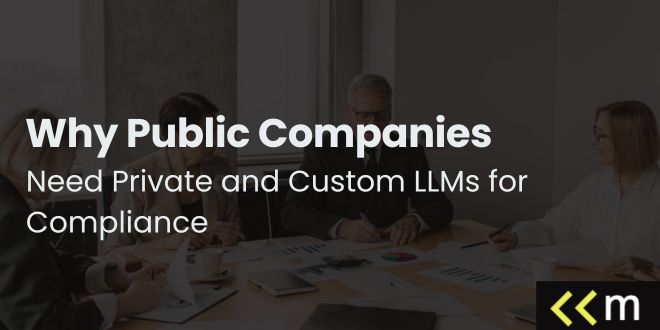The Biggest Challenges for Implementing Private Large Language Models (LLMs)

Private large language models (LLMs) promise transformative potential for enterprises seeking to control their AI destiny — from securing sensitive data to generating real time insights, leveraging rapid data processing, and building intelligence around domain specific data.
But building and operating private machine learning models and language models isn’t as simple as plugging in a pretrained system and hitting "go."
There are major operational challenges, primary challenges, critical infrastructure requirements, and ethical concerns at every stage — from compute and data security to large language model operations, AI deployment, and long‑term scalability.
Let’s break them down.
Infrastructure, Cost, and Environmental Complexity
Private, custom LLMs demand serious hardware muscle: multi‑graphics processing units (GPU) servers (often using A100s, H100s, or tensor processing units) high‑speed storage, model parallelism, and specialized networking. This comes with:
- Sky-high capex for purchasing specialized hardware, GPU racks, and setting up facilities using substantial computational resources.
- Massive energy consumption — running inference and model training for complex models consumes enormous power, contributing to a larger carbon footprint and higher operational costs.
- Cooling and heat dissipation challenges — GPU racks produce significant heat, requiring advanced cooling (liquid or high-capacity air systems).
- Acoustic pollution — GPU enclosures are loud, often exceeding 75 dB. Without proper sound isolation, they can make office environments intolerable.
As many organizations consider deploying LLMs using hybrid cloud architectures or cloud providers, they begin realizing the intense computational requirements, computing power, computational resources, and resource intensive nature of these workloads.
Data Privacy vs. Data Availability
Private LLMs promise tighter control over sensitive information — but achieving this balance is difficult. Most organizations struggle to compile high-quality internal datasets for training or fine-tuning, while navigating complex regulatory compliance, regulatory regulations, and data privacy concerns like GDPR, HIPAA, or CCPA.
The paradox: the very relevant data that can make a private LLM valuable (customer records, proprietary research, contracts) is often legally or ethically restricted from being used in training.
- Data sourcing bottlenecks: Sensitive internal data often lives in fragmented systems and formats, making data access difficult.
- Annotation and labeling at scale: Even when data is available, ensuring it's labeled correctly (without violating privacy) is expensive, time consuming, and error-prone.
- Synthetic data isn’t a panacea: While generating synthetic data can reduce privacy risk, it rarely fully captures the nuance needed for high-quality model outputs, especially in sensitive domains.
- Case example: A healthcare org trying to fine-tune a private LLM on medical records may need to anonymize records — but de-identification processes can strip crucial context required for accurate language patterns, reducing model utility.
Security and Compliance Risks
Owning your LLM means owning your risk surface. Private deployments place the responsibility for data security, model management, and regulatory compliance squarely on internal teams.
Key challenges include:
- Attack surfaces unique to language models: Prompt injection, output poisoning, and model inversion attacks can expose sensitive data or cause unintended outputs.
- Compliance overhead: Meeting SOC 2, ISO 27001, HIPAA, or CMMC standards requires building rigorous controls for everything from data encryption to audit logging and access management.
- Secure inference and API exposure: Serving private LLMs often requires API endpoints to prevent unauthorized data access — which can be a magnet for attackers if not hardened properly.
- Model theft risks: If your valuable fine-tuned model weights (or multiple models) are not secured, they could be exfiltrated and reused by competitors or bad actors.
Example: A bank deploying a private LLM must ensure that queries and outputs containing sensitive financial information can’t be logged or leaked — internally or externally.
Technical Expertise and Talent Gaps
Operating private LLMs requires a cross-functional team spanning:
- AI/ML engineering (model design, fine-tuning, evaluation)
- MLOps / DevOps (infrastructure scaling, monitoring, DevOps CI/CD pipelines for model deployment, AI inference, and orchestration)
- Cybersecurity (protecting data, endpoints, model weights, and outputs)
- Compliance and AI governance (ensuring ethical and legal use)
The reality:
- There’s a global shortage of professionals who combine these skills.
- Hiring or upskilling these teams is expensive and slow — often taking 12+ months to build a capable in-house team.
- Keeping talent current on rapidly evolving AI stacks (e.g., transitioning from transformer architectures to next-gen models), model complexity, and future scaling AI requirements adds pressure.
Model Performance and Maintenance
Deploying a private LLM isn’t a “set it and forget it” task.
Model performance degrades over time due to model drift, data shifts, and changing real-world context.
Key pain points include:
- Monitoring model behavior: You’ll need tools to detect hallucinations, bias, and degraded model outputs — ideally in real-time.
- Retraining cycles: Staying accurate means frequent fine-tuning or re-training, requiring continuous access to clean, new data and updated relevant data.
- Bias and toxicity management: Without vendor support, the burden of detecting and mitigating harmful outputs (e.g., discriminatory or offensive language) is fully on your team.
- Explainability challenges: Making internal stakeholders comfortable with model decisions requires building or buying tools for interpretability — a complex task for machine learning models.
Example: A private LLM fine-tuned on internal customer support data may start hallucinating answers as product lines change — requiring frequent re-training to stay relevant.
Private LLM owners must also focus on continuous improvement, keeping responses accurate, and leveraging user feedback and customer feedback.
Integration with Existing Systems
One of the most underestimated challenges in private LLM deployment is integration with existing systems — embedding the model into real business workflows, software systems, and user experiences.
Deploying the model is just the beginning. From there:
- APIs and orchestration: Private LLMs must be served through secure, well-documented APIs, often using gateways that manage authentication, throttling, and logging. Integrating these with internal apps, chatbots, data pipelines, or orchestration layers compatible with cloud platforms and cloud services can require months of engineering effort.
- Legacy system compatibility: Many enterprises run critical systems on legacy platforms that weren’t designed for modern AI workloads. Bridging LLM capabilities with these systems often requires custom middleware that can handle latency constraints, real time responses, and heavy AI inference workloads.
- Latency and throughput challenges: Unlike SaaS LLMs (which often run on massive hyperscale infrastructure), private models can struggle to deliver low-latency responses at high concurrency, especially without GPU-backed support for vector databases for retrieval augmented generation.
- Change management: Synchronization with remote servers, cloud providers, or hybrid cloud setups. Even when technically integrated, getting teams to adopt and trust the new AI capabilities can be a major hurdle.
Example: A law firm deploying a private LLM to assist in contract review might spend more time integrating it with their document management system and ensuring compatibility with various file formats than adjusting model training pipelines.
Ethical and Responsible AI Concerns
When you own the model, you own the consequences. Unlike using a third-party API where responsibility for fairness, explainability, and harm mitigation rests (at least partly) with the vendor, private LLMs shift these burdens internally. Organizations must handle ethical challenges, ethical consideration, fairness testing, governance frameworks, and model outputs risks.
Key challenges include:
- Bias and fairness audits: You must proactively test and mitigate for bias against protected classes or other unfair treatment — which is non-trivial at scale.
- Explainability tools: Internal stakeholders (and sometimes regulators) will demand to understand how decisions are made — but building or integrating explainability tools for large models is technically challenging and often incomplete.
- Accountability frameworks: When something goes wrong (e.g., a hallucination that leads to bad business decisions), it’s unclear who within the organization is accountable unless governance structures are well defined and made from critical insights.
- Content safety mechanisms: Without the vendor’s built-in safeguards (e.g., OpenAI's moderation layers), you must ensure compliance with relevant regulations in sensitive domains.
Example: A financial services firm using a private LLM for customer support might face reputational risk if the model generates harmful responses — and will need internal systems to catch and correct such outputs in real time.
Scalability and Future-Proofing
What works today might not work tomorrow. A private LLM solution that handles your current workload could quickly become obsolete as:
- Model sizes grow: Moving from a 7B to a 70B parameter model (or beyond) might require an entire re-architecture of your hardware, networking, and serving strategy.
- Workload increases: As more teams and cloud providers find ways to use the model, you may face unexpected spikes in demand, forcing you to scramble for additional compute.
- Technology shifts: Advances in hardware (e.g., next-gen GPUs, TPUs, or even quantum accelerators) could render your existing investments suboptimal, creating expensive technical debt and expanded use cases across AI projects.
- Standards and regulations evolve: There needs to be infrastructure limits when scaling LLMs or scaling AI. What passes compliance today may fail tomorrow — requiring rework of your systems and processes.
A private LLM solution capable of handling current volumes may be insufficient when new teams integrate workloads, increasing model parallelism, GPU usage, memory usage, and computational demands.
Smart planning involves modular design, flexible infrastructure (e.g., hybrid on-prem + cloud options), and constant horizon scanning — but this adds further complexity and cost.
Example: A retailer that initially deploys a small private LLM for internal search and recommendations might find, within a year, that growing data volumes and use cases demand a much larger model — outstripping their original infrastructure.
Enterprises must optimize performance, enhance performance, ensure cost effective compute, avoid vendor lock in, and adapt to shifts in hardware and specialized hardware such as TPUs.
Private LLM Challenge Matrix
Here’s a visual of the key challenges, their impact, and the complexity of solving them:
Is the Private LLM Promise Practical?
Private LLMs offer a powerful competitive edge, especially when deploying LLMs for customer inquiries or internal automation. But the core challenges — financial, technical, operational, and ethical — are substantial.
Successful deployments require strong teams, hybrid strategies, and thoughtful planning across critical infrastructure, AI deployment, and long‑term model management.
At LLM.co, we help organizations navigate these complexities, delivering tailored private LLM solutions that balance control, cost, and capability.
Eric Lamanna is VP of Business Development at LLM.co, where he drives client acquisition, enterprise integrations, and partner growth. With a background as a Digital Product Manager, he blends expertise in AI, automation, and cybersecurity with a proven ability to scale digital products and align technical innovation with business strategy. Eric excels at identifying market opportunities, crafting go-to-market strategies, and bridging cross-functional teams to position LLM.co as a leader in AI-powered enterprise solutions.







